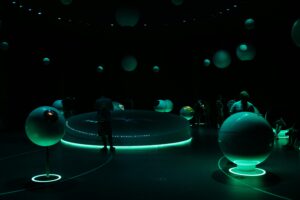Immersive Experiences: How Interactive Installations Are Transforming Modern Events


Modern events have evolved far beyond traditional presentations and static displays. Today, audiences expect engagement, creativity, and participation — interactive installations deliver precisely that. These immersive setups blend art, technology, and storytelling to create memorable, sensory-rich experiences that leave lasting impressions on attendees.
Interruptive installations have become the cornerstone of event innovation, from corporate conferences to music festivals and product launches. They bridge the gap between entertainment and engagement, inviting participants to become active contributors rather than passive observers. This transformation has redefined what it means to connect and communicate in real time.
Technology as the Heart of Engagement
Cutting-edge technology is at the core of modern interactive installations. Motion sensors, virtual reality (VR), augmented reality (AR), and projection mapping allow event designers to blur the line between physical and digital spaces. Attendees can enter virtual worlds, manipulate digital elements, or trigger visual and auditory effects through movement or touch.
This technological integration enhances visual appeal and deepens emotional connection. When guests can interact directly with an installation, they form a personal bond with the brand or message behind it. These experiences will become even more dynamic, customized, and unforgettable as technology advances.
Creating Emotional and Sensory Impact
Interactive installations work because they appeal to multiple senses at once. Unlike static exhibits, they encourage physical movement, visual exploration, and emotional response. For example, light installations responding to touch or sound can evoke awe and curiosity, while immersive soundscapes can transport audiences into new emotional dimensions.
Emotional engagement is one of the strongest tools in event storytelling. When participants feel personally involved, they’re more likely to remember the experience and its message. Successful installations balance innovation and intimacy, ensuring that every interaction feels purposeful rather than purely technical.
Brand Storytelling Through Interaction
Brands are increasingly turning to interactive installations as storytelling tools. These experiences allow companies to communicate values, missions, and product features in organic and memorable ways. A fashion brand might use motion-sensitive mirrors that project designs onto attendees, while a tech company could build a VR journey showcasing its innovation timeline.
The power of this approach lies in immersion. When attendees engage physically with a brand’s story, they internalize it deeper. Instead of being told about a product or idea, they live it. That level of participation transforms brand communication from passive observation into active experience — a powerful strategy in modern marketing.
Encouraging Social Sharing and Viral Appeal
Interactive installations are built for the age of social media. Their visually striking, hands-on nature makes them irresistible to capture and share online. Whether it’s a color-changing LED wall, a kinetic sculpture, or a digital graffiti wall, these installations encourage organic promotion as attendees post photos and videos across platforms.
Event organizers understand the marketing potential behind these shareable moments. Many installations now incorporate hashtags, QR codes, or custom filters to amplify online engagement. This boosts event visibility and extends its reach far beyond the venue — turning attendees into brand ambassadors by simply sharing their experience.
Sustainability and Purpose in Design
As event design evolves, sustainability has become essential in interactive installations. Many creators use recycled materials, energy-efficient lighting, and reusable components to minimize environmental impact. The goal is to merge creativity with responsibility, proving that immersive experiences can be visually stunning and eco-conscious.
Beyond materials, purpose-driven installations are gaining popularity. Many events use interactive art to raise awareness about social or environmental issues, encouraging audiences to engage with meaningful causes. This fusion of innovation and intention gives installations greater depth, allowing them to inspire action and admiration.
The Future of Interactive Experiences
The future of interactive installations lies in personalization and inclusivity. Emerging technologies like artificial intelligence and biometric sensors will soon enable real-time customization based on individual responses. Imagine an installation that changes color based on a visitor’s heartbeat or generates soundscapes from collective audience movement — the possibilities are limitless.
Inclusivity will also take center stage, ensuring these experiences are accessible to all attendees regardless of ability. As designers focus more on universal engagement, interactive installations will continue to shape the next generation of events, fostering connection through creativity and innovation.
Final Thoughts
Interactive installations have redefined modern events as gatherings and shared experiences that engage, inspire, and connect. By combining art, technology, and human emotion, they transform ordinary spaces into extraordinary moments of creativity and participation.
In an age where audiences crave authenticity and engagement, interactive installations offer the perfect blend of both. They don’t just entertain; they empower people to be part of the story. As events evolve, these immersive creations will remain at the heart of how we experience connection in a digital world made human again.
